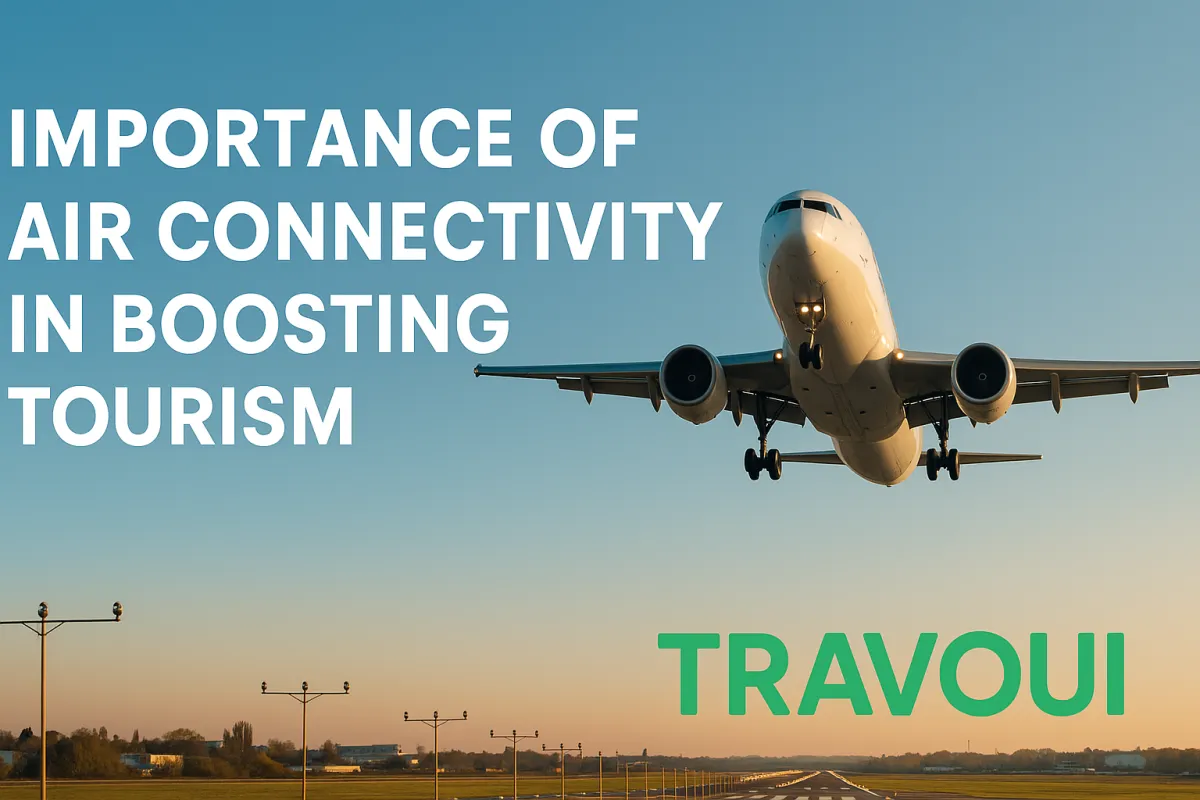
🌐 The Importance of Air Connectivity in Boosting Tourism Growth
🧭 Introduction
In tourism, there’s one undeniable truth: “If they can’t reach you, they won’t come.” Air connectivity is not just about flights—it’s about access, visibility, competitiveness, and economic uplift. Across the world, high-performing destinations have leaned on their national carriers as strategic allies to unlock market access, drive visitor numbers, and boost long-term tourism growth. This article explores the pivotal role that air connectivity plays in tourism development—and why tourism boards and airlines must jointly plan over a 5–10 year horizon to build competitive, connected, and future-ready destinations.
✈️ Why Air Access Drives Tourism Success
Air connectivity shortens distance, reduces friction, and transforms destinations from dreams into bookings. A direct flight often makes or breaks a traveler’s decision—especially in long-haul markets. Take a look at how national airlines have successfully fueled destination success: · Emirates (UAE): Emirates and Dubai Tourism collaborate on route development and promotions. Their co-branded “Hello Tomorrow” campaign helped elevate Dubai to one of the world’s most visited cities. · Singapore Airlines (Singapore): In partnership with Singapore Tourism Board, the carrier ensures Singapore is marketed as a primary destination—not a mere stopover. · Qatar Airways & Qatar Tourism: Qatar’s global tourism rise—especially around FIFA 2022—was backed by proactive route expansion and capacity building by Qatar Airways. · Turkish Airlines (Turkey): With strong support from the Turkish Tourism Board, Turkish Airlines promotes not just Istanbul, but lesser-known regions through powerful global storytelling.
🌏 Airline Corridors Fueling Asia–Americas Growth
As travel flows increase between Asia and the Americas, airline partnerships form the critical backbone of growth: · Air Canada: With direct flights from Toronto and Vancouver to Delhi, Mumbai, Tokyo, Seoul, and São Paulo, Air Canada positions Canada as a vital transpacific and pan-American hub. · ANA & Japan Airlines: These carriers connect Japan with major U.S. cities and secondary markets in Latin America. JNTO campaigns have helped expand interest far beyond Tokyo. · LATAM Airlines: With routes between Brazil, Chile, and key Asian hubs (via codeshares with Korean Air and Cathay Pacific), LATAM supports seamless multi-destination tourism. · Korean Air: With major gateways in North America (LAX, JFK, YYZ, YVR), Korean Air helps position South Korea as a year-round cultural, MICE, and diaspora-friendly destination. · Cathay Pacific & EVA Air: Working with their tourism boards, they co-host trade roadshows in Canada, the U.S., and Latin America—generating strong inbound demand for Hong Kong and Taiwan. · Vietnam Airlines & Bamboo Airways: As Vietnam rises in global tourism, new North America routes (San Francisco, Vancouver) are matched with targeted campaigns for diaspora and leisure segments.
🤝 The Power of Alignment: Airlines + Tourism Boards = Growth
Destinations that win aren’t just scenic—they’re accessible and strategically marketed. Long-term growth stems from synergy between tourism and aviation sectors. Here’s how high-performing destinations align for success: ✅ 5–10 Year Joint Roadmaps
Co-develop strategic plans focused on source market development, visa facilitation, airport upgrades, and segmented visitor targeting (luxury, VFR, MICE, adventure). ✅ Route Planning Based on Market Intelligence
Tourism boards offer data on high-potential markets. Airlines use it to optimize capacity, frequency, and schedules for better load factors and sustainability. ✅ Joint Infrastructure Investment
Growth requires smart investment in terminals, lounges, transit access, and border processing. Planning should be collaborative from the start. ✅ Shared Vision of Target Markets
Destinations and airlines should agree on market priorities and collaborate on culturally relevant efforts—like offering regional cuisine onboard or customized language support in campaigns.
🛬 Airlines Should Be at the Heart of Destination Promotion
Many destination campaigns lead with “what to see” but skip “how to get there.” This is a missed opportunity. Airlines should be integral to tourism marketing. Here’s why their inclusion is strategic: · 🔸 Co-branded promotions amplify reach and communicate ease of access. · 🔸 Direct flight mentions in B2C content simplify traveler decision-making (“Fly direct to Tokyo with ANA”). · 🔸 Trade participation from airlines in exhibitions builds package-ready itineraries with OTAs and advisors. 📉 On the flip side, destinations overly dependent on connecting flights or stopovers lose out. Transit hubs often capture overnight stays, spend, and even traveler loyalty—before the final destination sees any value.
🔮 The Future of Air Connectivity & Tourism
Airlines and tourism boards must be more integrated than ever, especially in today’s evolving travel landscape shaped by: · ✈️ Surging outbound growth from markets like India, Vietnam, and Mexico · 🌱 Sustainability demands, requiring more efficient route planning and offset strategies · 💼 Business travel recovery, emphasizing premium and flexible cabin strategies · 🤖 Data and tech integration for personalized booking paths and smarter market targeting Those who shape the skies collaboratively will shape the future of demand.
✅ Final Takeaway
Air connectivity is not a background operational issue—it’s a frontline driver of tourism success and national competitiveness. Destinations that coordinate with their national airlines—through shared priorities, market strategies, and infrastructure plans—will unlock sustainable growth. Others risk watching their potential fly overhead—unrealized.
🚀 Let’s Build Air Strategies That Drive Real Tourism Growth
At TRAVOUI, we help destinations align aviation and tourism ambitions. From air route pitches and market prioritization to co-branded marketing and airport readiness—we help destinations turn connectivity into competitiveness.
© Copyright 2025. Canada. All rights reserved.

